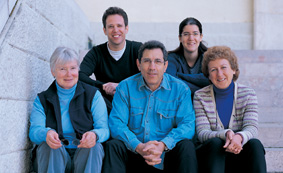Weizmann Institute scientists discovered: how bone joint cells build a wall that delimits the area of activity
 From the right: Prof. Lea Addi, Dafna Geblinger, Prof. Benjamin Giger, Chen Luxenberg and Dr. Eugenia Klein. the secret of the ring
From the right: Prof. Lea Addi, Dafna Geblinger, Prof. Benjamin Giger, Chen Luxenberg and Dr. Eugenia Klein. the secret of the ring
The bones in the bodies of various animals, including humans, undergo constant renovations in which old material is broken down and removed, so that a new bone can be formed in its place. An imbalance in this process may cause the loss of bone material, a process that occurs, among other things, in osteoporosis. Therefore, understanding the constant remodeling process of the bone may help in the study of these diseases. Weizmann Institute scientists recently revealed, in great detail, the way in which migratory cells, which absorb bone, seal the working area in the space between the cell and the bone, during their activity. These findings were recently published in the scientific journal PLoS ONE.
These cells, called osteoclasts, are characterized by unique properties that hardly exist in other cells. The osteoclasts move on top of the bone, until they reach the site where their services are needed. When they receive the signals instructing them to break down the bone in this area, they go through a process of polarization, adhere firmly to the surface of the bone, and build the isolation ring that maintains the existence of an acidic local environment and a sufficient presence of protein-degrading enzymes.
How is this insulating ring formed? To find an answer to this question, Prof. Benjamin Giger from the Department of Molecular Biology of the Cell and Prof. Lea Addi, from the Department of Structural Biology at the Weizmann Institute of Science, established a multidisciplinary research team that included research students Chen Luxenberg and Dafna Geblinger, as well as Dr. Eugenia Klein. The team collaborated with Prof. Dorit Hanin and Karen Anderson, from the Burnham Institute, in San Diego. The scientists used, in combination, two complementary research methods, which allowed them to examine the structure of polarized osteoclasts. Imaging using an electron microscope allowed them to see the details of the ring's structure. A light microscope allowed them to accurately identify the molecular components of the ring. The combination of the two methods created an accurate image that could not be obtained with one method.
In this way, the scientists were able to see that the ring consists of point-like structures, called podosomes, which are anchored to the cell membrane. When the osteoclast is in motion, the dots are disorganized, but as soon as the cell prepares to digest bone, the individual podosomes disappear and the ring appears. The scientists were not sure what the connection between the podosomes and the production of the ring was. Do they form the ring? Do they merge for that? Or is the ring made from other units? The use of the combined observation method allowed the scientists to discover that the ring is indeed composed of podosomes, and that it is held in place thanks to protein fibers that connect to the podosomes. "The podosomes act as a kind of parental dancers," says Prof. Giger. "As soon as the music starts, they join hands and form a tight circle. From a distance, it is difficult to distinguish the individual dancers, but the use of a combination of the different microscopic methods allows this distinction."
Prof. Eddi has a different image: "The individual podosomes look, from above, like circus tents, with rope-like lines coming out of a central mast." She also believes that the podosomes may play a role in communication between the outside and the inside of the cell, which allows the cell to regulate its activity according to the properties of the bone to which they attach.

3 תגובות
Ami, it means that specific molecules have been labeled with immunofluorescent markers, which are identified in a light microscope.
Link to article:
http://tinyurl.com/2gqjcp
By the way, articles published in PLoS are accessible to everyone.
It would be nice if a link to the original article was attached.
"Electron microscope imaging allowed them to see the details of the ring's structure. A light microscope allowed them to accurately identify the molecular components of the ring. The combination of the two methods created an accurate picture that could not be obtained with one method."
Probably the opposite. With a light microscope it is not possible to clearly see components smaller than one micron.
Also, I did not understand the need for such a large group of multidisciplinary researchers with a molecular background. If it is only a matter of microscopy, then this is puzzling.